When after the tasty dinner in Merida I returned to my guest-house, I started to get ready to go to bed, as well as for the trip to the archaeological site Uxmal that I planned for the following day. This also meant the change of clothes. However, when I took off the t-shirt I wore the whole day in excessive heat, which meant that the t-shirt was full of by now dried out sweat, I realised there was no way I could put that t-shirt in my backpack, even if I would wrap it up in a plastic bag first. So, I simply washed it using an ordinary soap and when I rinsed it I put it on a plastic coat-hanger and let it dry in the bathroom.
In the morning the t-shirt was dry and apart from not being pressed it seemed quite decent and was actually not even very creased since I had flattened it nicely on the coat-hanger the night before. I have a very good sense of smell, so like a hound dog I started to sniff my t-shirt. Except for a distant smell of soap it did not smell of anything else. And then an idea dawned on me, but it involved an experiment in the shape of wearing the same t-shirt two days in a row, with thorough washing in-between. As it would turn out, neither the t-shirt nor I smelled badly in the evening and there, learning one of the most important lessons for long journeys, I started to wash my clothes regularly when I retired to my room in the evening. In this way, during the month I travelled I used only 1 skirt, 1 Bermuda shorts, 1 pair of light trousers, 2 t-shirts and 1 shirt! During one entire month! What I want to say is that all the pile of clothes that I carried in my backpack for the whole month was a pure – surplus! But, the good thing is that I learned a very valuable lesson.
So, that morning, wearing the same, but still clean t-shirt I had had on the day before I went to the coach terminal since already upon my arrival in Merida I bought the ticket to Uxmal. This is yet another important archaeological site of the ancient Maya people in Yucatan. The coach was almost half an hour late when departing, but I still left early enough that I knew I would have the time to visit the site at leisurely pace. And so I had, since I arrived in Uxmal that is located some 70 km south of Merida around 9.30 am. Another advantage of such early arrival was that it was still not too hot. Moreover, the weather was perfect – the sky was blue and cloudless, the temperature was pleasant and there was also a light breeze.
As for the Mayan town of Uxmal, it is not quite clear when it was founded (some data mention around 500 CE and some other the 7th century) or how many people actually lived there, but it is estimated that at its high point the city had around 20,000 residents. I have already mentioned before that the civilisation of the ancient Maya did not constitute a single, unified state, but rather this was a cluster of cities that were the centres of their own respective states, while mutually waging wars or possibly formed alliances (in order to wage wars with others). Thus, Uxmal was the capital of the regional state of Puuk in the period from 850 until 950 CE, which falls into the Late Classic Period and the majority of the most important buildings were constructed precisely in this period (although some were built even before), but the city was abandoned by its population already around 1000 CE.
By the way, Puuk is the name of the region that covers the area of around 7500 square kilometres, ruled by Uxmal, as well as the name of a very specific architectural style which reached its summit precisely here in Uxmal. The word “Puuk” is derived from a Mayan word for “hill” since, unlike the rest of Yucatan that is flat, here there are hillocks.
As for the name Uxmal, there are different opinions about the origin of the word, but the most popular theory is that in the Maya language Uxmal means “thrice built” suggesting the advanced age of the city (which would actually be a marketing stunt from the ancient times, for when you look at the years of the founding and the abandonment of the city it can easily be concluded that it was not that old, but this certainly sounds better).
What is interesting about the general layout of the structures within the city is that it reflects the Maya’s (advanced) knowledge of astronomy and thus its space is organised in relation to the rising and setting of Venus, while also being accommodated to the topography, that is, the hillocks which the architects in the other Mayan cities in Yucatan did not have to deal with.
Be as it may, when one enters the site of Uxmal, one first comes across the most important structure and that is the Pyramid of the Soothsayer (the Magician) (Pirámide del Adivino).
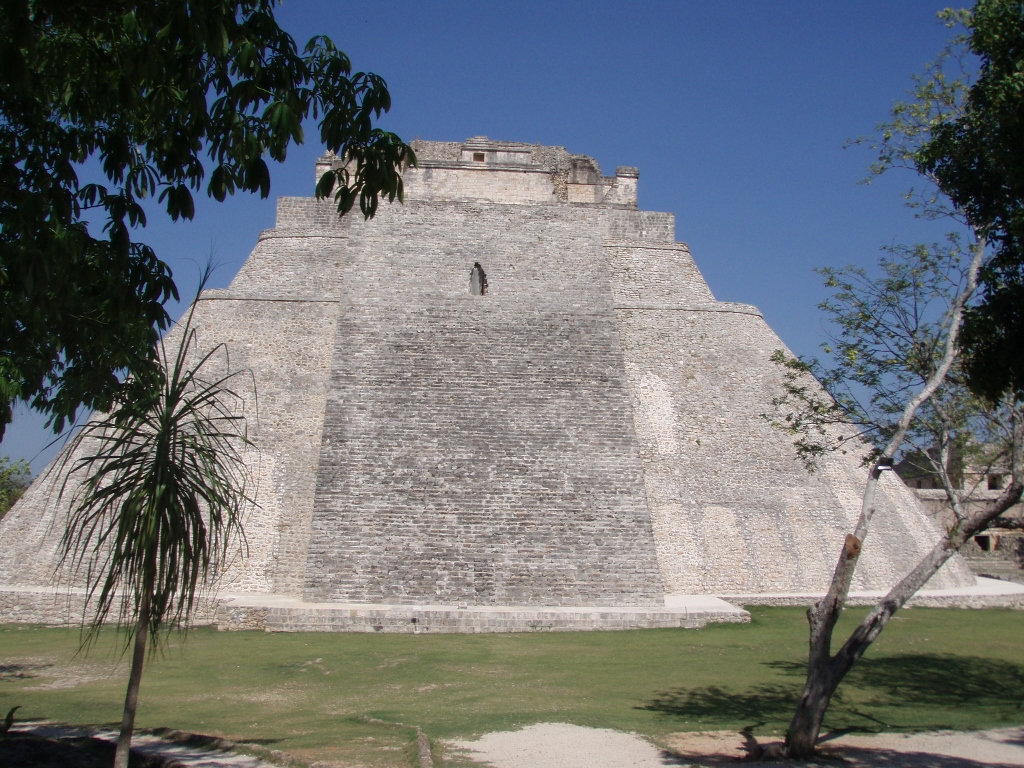 Pyramid of the Soothsayer
Pyramid of the Soothsayer
It needs to be said here that the real function of most of the structures here is not actually known, but all the picturesque names come from the Spanish who gave them when they first conquered these territories.
In any case, the Pyramid of the Soothsayer is the highest structure in Uxmal, 35 metres high, and it dominates the ceremonial centre of Uxmal. The pyramid is very unusual for it has an oval ground plan. According to the legend, it was built over a single night by a dwarf with supernatural powers, but in reality its construction started in the 6th century CE, while the original temple was added to over the course of the following 400 years.
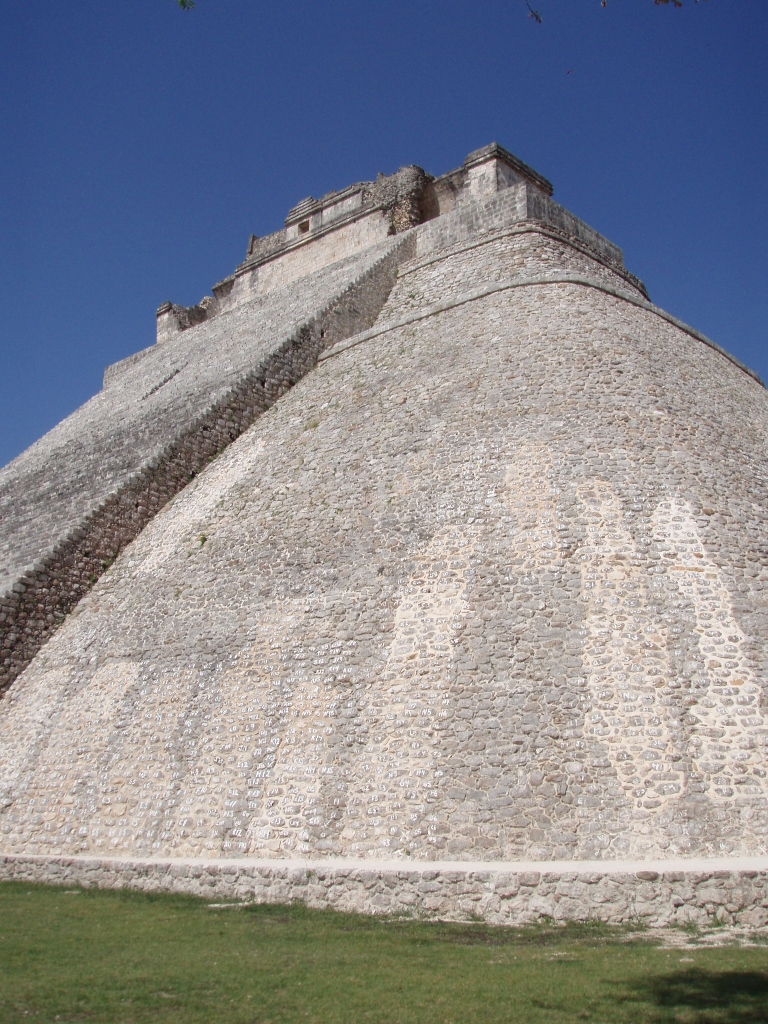 Pyramid of the Soothsayer – its oval shape can be seen well from this angle
Pyramid of the Soothsayer – its oval shape can be seen well from this angle
In fact, this pyramid consists of five temples built one on top of the other.
The oldest is Temple I and it is covered by the pyramid, but it may be reached through a passageway that exists on the west side of the Pyramid. However, after a very nasty hurricane from 1988 and a large quantity of rainfall, the passageway was closed in order for the structure to be protected, since it is anyway partially collapsed. Temple I indisputably dates back to the 6th century and some of its parts may be seen from the west side of the Pyramid.
Temple II has its direct entrance, although the visitors are no longer allowed access to any of the temples, and that opening may be seen on the east side on the stairway leading to the top of the pyramid. The entrance into Temple II can be seen on my first photo from Uxmal as a dark patch in the middle of the stairway and it may also be partially discerned as a thin cut in the stairway in the photo above.
Temple III was built into the rear section of Temple II and it cannot be seen from the outside at all. It consists only of the central shrine and an antechamber. Practically speaking, Temple III is actually squeezed between Temple II and Temple IV.
Temple IV is located at the level of the second and the third steps of the pyramid, its entrance is from the west side and it is the most opulently decorated temple here. The decoration on the facade of the entrance depicts in fact the rain god Chaac and it is made in such a way that the opening serving as the entrance constitutes the mouth of god Chaac.
And, finally, Temple V, also called the House of the Soothsayer (Magician), is situated at the very top of the pyramid and it has a rectangular ground plan. It was built around 1000 CE. With its appearance it reminds of the nearby Governor’s Palace, only it is significantly smaller and consists of three rooms. Also, from a trench in its floor it is possible to see the roof comb belonging to Temple II. (The Mayas used these roof combs from time to time as a decoration on the top of their temples and the best known examples are found in Tikal in Guatemala. This will be covered later by the stories of my travel around Mexico and Central America.)
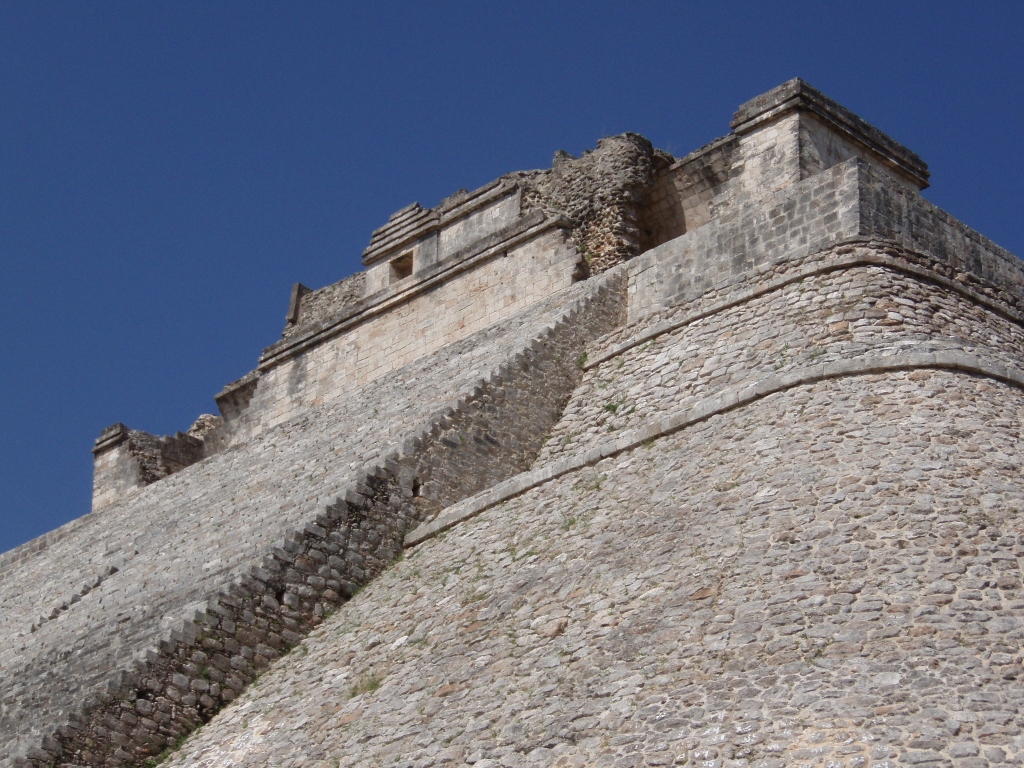 Details on the east side: down to the left is a small skewed “cut,” being the entrance into Temple II, and the back side of Temple V at the top of the stairs
Details on the east side: down to the left is a small skewed “cut,” being the entrance into Temple II, and the back side of Temple V at the top of the stairs
In any case, as I’ve said, the visitors are not allowed into the temples these days and to start with I contented myself by walking around the Pyramid of the Soothsayer from the north side. Again, its oval structure may be seen well from here.
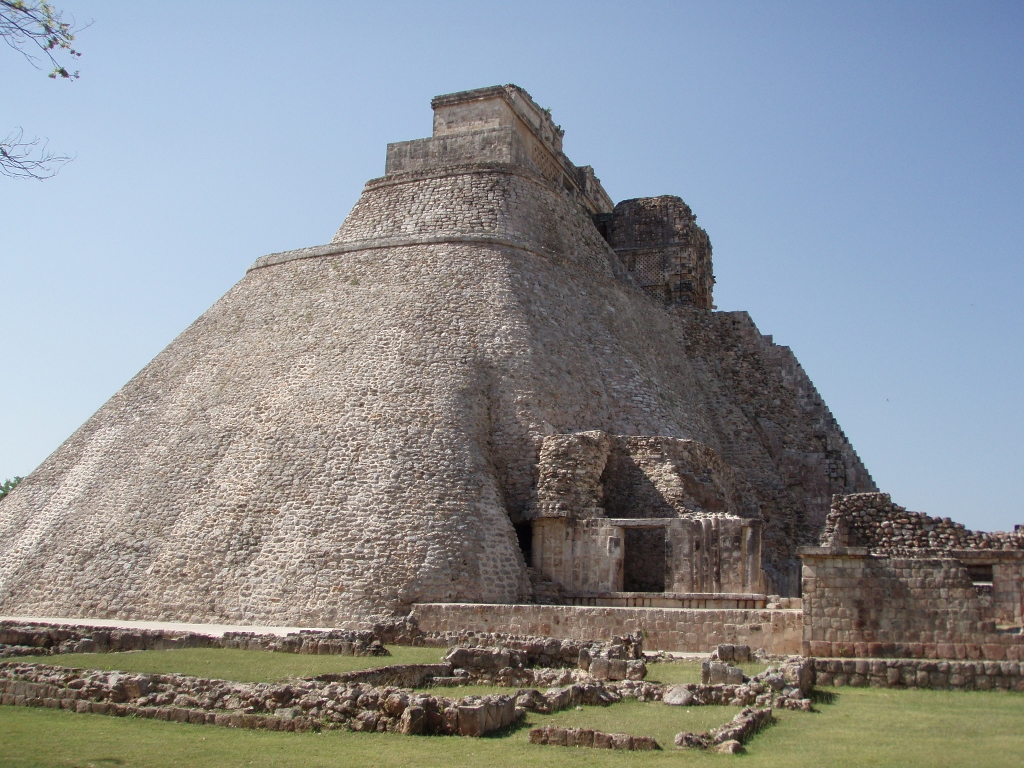 Pyramid of the Soothsayer – view from the north side
Pyramid of the Soothsayer – view from the north side
On the northwest side of the pyramid there are structures that are more or less destroyed, but there is also a path leading to the next important structure, the Nunnery Quadrangle (Cuadrangulo de las Monjas). Still, before getting to the structure itself and the quadrangle, I could see some of its parts, such as the north wing built on a mild elevation or the exterior facade of the east wing.
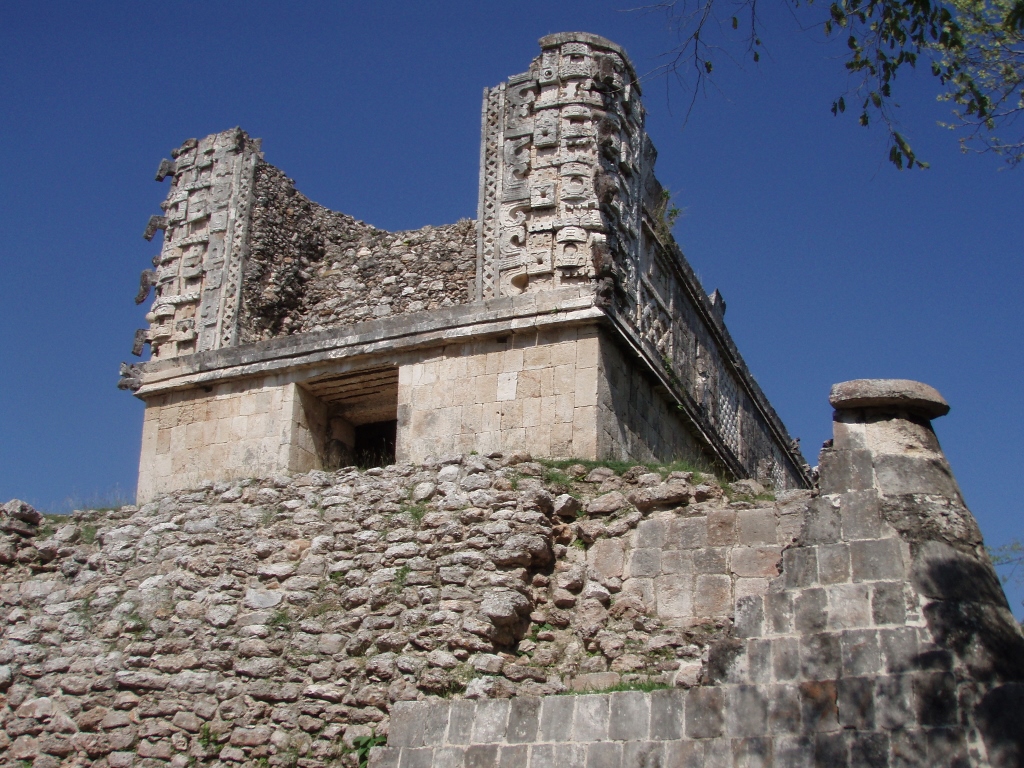 Nunnery Quadrangle, a detail of the north wing
Nunnery Quadrangle, a detail of the north wing
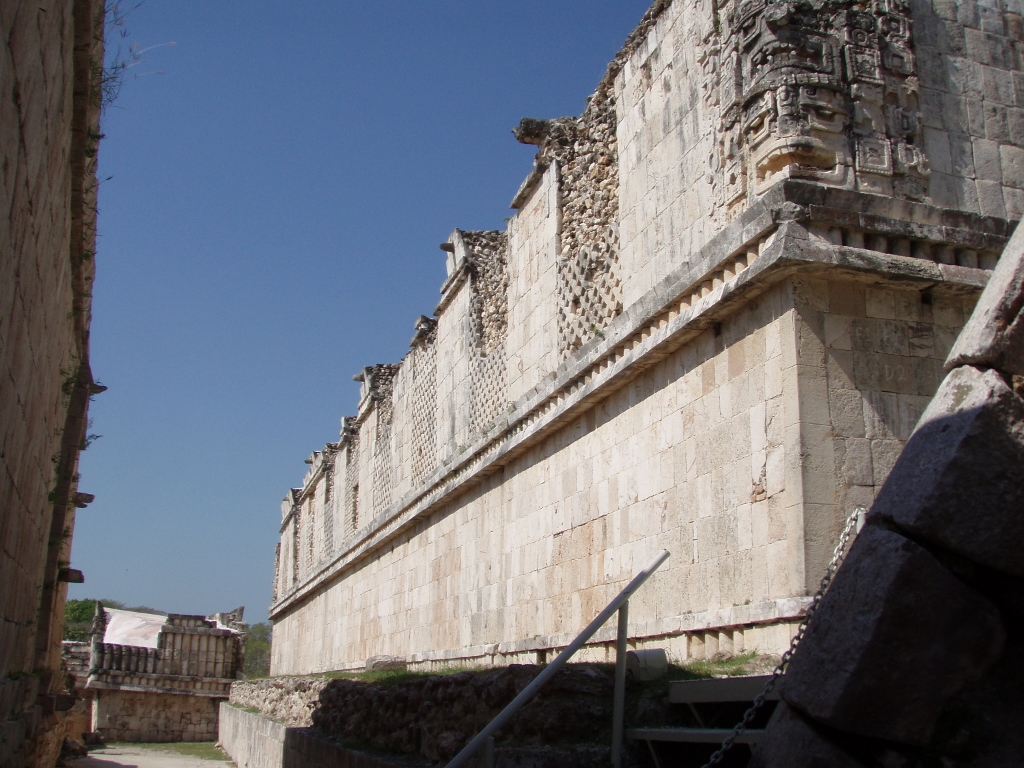 Nunnery Quadrangle, exterior facade of the east wing
Nunnery Quadrangle, exterior facade of the east wing
From this passage I could also see nicely the Pyramid of the Soothsayer, i.e., its west side and the entrances into Temple IV and Temple V.
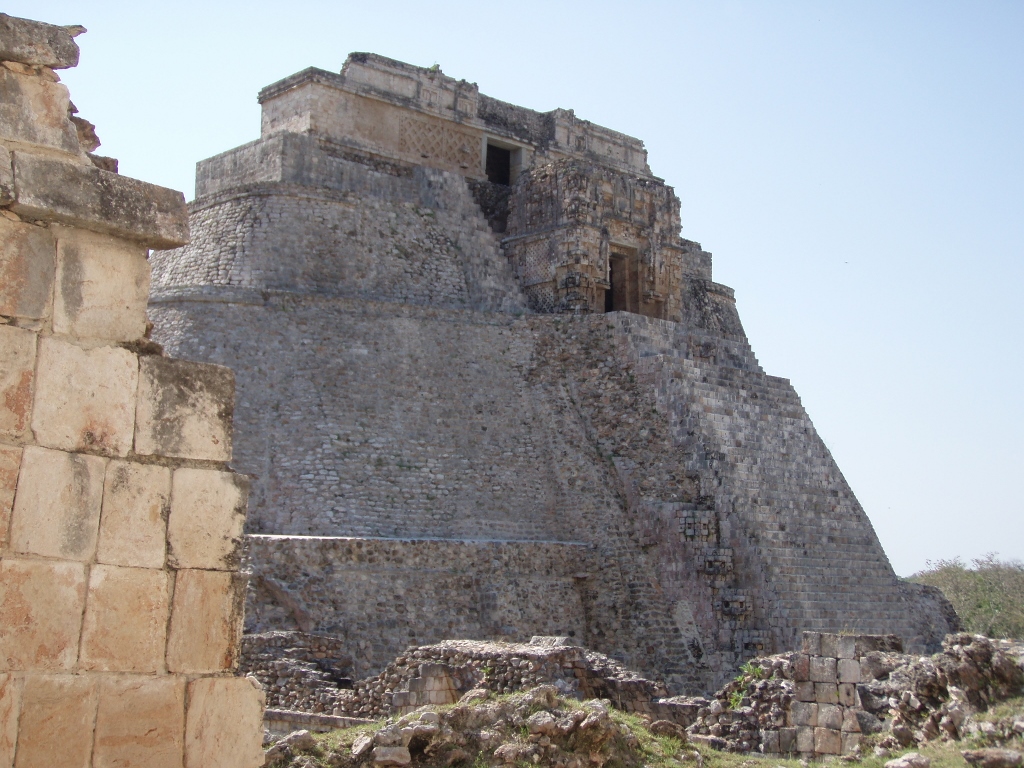 Pyramid of the Soothsayer – view at the west side
But, now I got to the Nunnery Quadrangle and so I dealt a little more with this structure where I first paid attention to the stone decoration on the southeast corner of the north wing. Like the previous couple of photographs show, here too one can see a myriad of details and several depictions of the god of rain and thunder, Chaac.
Pyramid of the Soothsayer – view at the west side
But, now I got to the Nunnery Quadrangle and so I dealt a little more with this structure where I first paid attention to the stone decoration on the southeast corner of the north wing. Like the previous couple of photographs show, here too one can see a myriad of details and several depictions of the god of rain and thunder, Chaac.
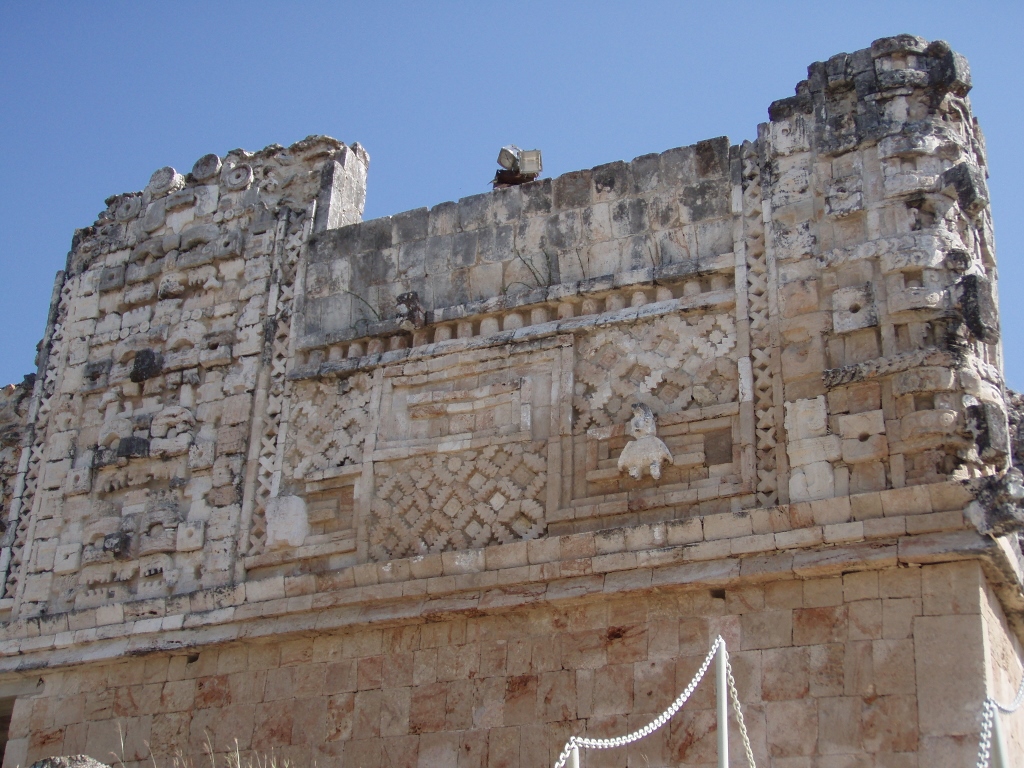 Nunnery Quadrangle – stone decoration including the depictions of god Chaac
Nunnery Quadrangle – stone decoration including the depictions of god Chaac
Let me remind you – Chaac was the god of rain and thunder, and since its activities were linked to the rainfall and consequently to agriculture and growing of crops, he was very important for the ancient Maya and here there are plentiful depictions of god Chaac. Namely, as opposed to Chichén Itzá and other Mayan cities in Yucatan where there are cenotes, the natural wells with freshwater, these do not exist in Uxmal and the residents got their water here from water wells, cisterns, which they built themselves. It is precisely this situation with freshwater that can mean that the rain god was even more important here than in the other regions. By the way, let me reiterate that it is not know exactly why the ancient Maya disappeared from the historic scene. One of the possible theories is that different type of cataclysms started to appear, primarily those linked to the climate conditions, which they could not control.
Here is one photo of god Chaac from up close, as it used to be shown traditionally: in the middle of the photo is the nicely lit right-hand side of his face – you can see the eyebrow, the eye and below them the sneering sharp teeth. On the left-hand side of the photo there is also a square ornament for his right ear with a hole in the middle, while on the right-hand side of the photo, there is a dark red nose in the shape of a small trunk, as well as the left side of the face of god Chaac that is in the shade.
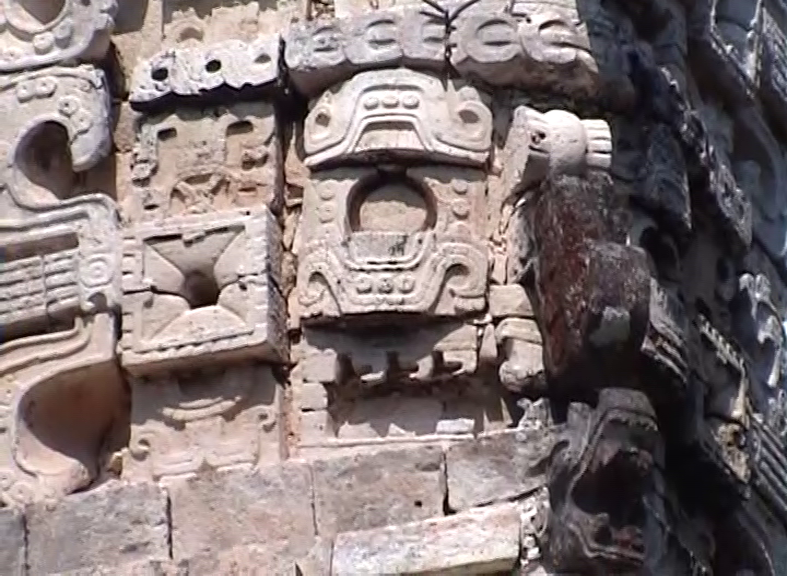 God Chaac
God Chaac
When following the visitors’ path that leads between the east and the north wings of the Nunnery Quadrangle I went up to the elevation that is at the level of the north wing I immediately faced a stunning view.
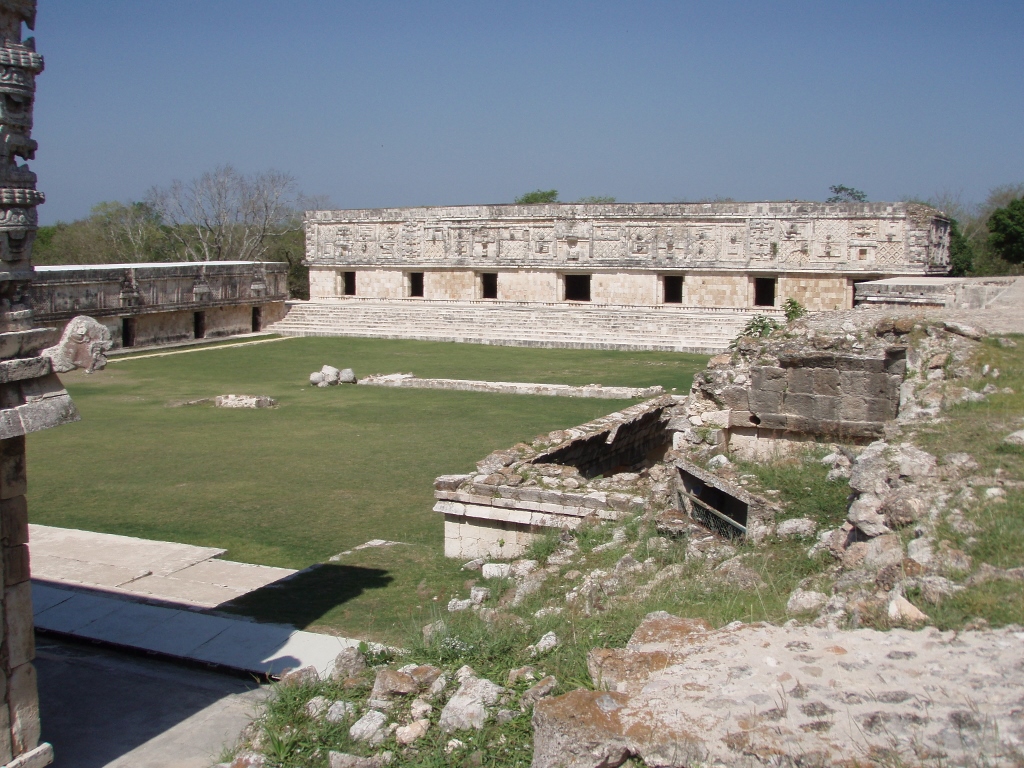 Nunnery Quadrangle – view at the west wing
Nunnery Quadrangle – view at the west wing
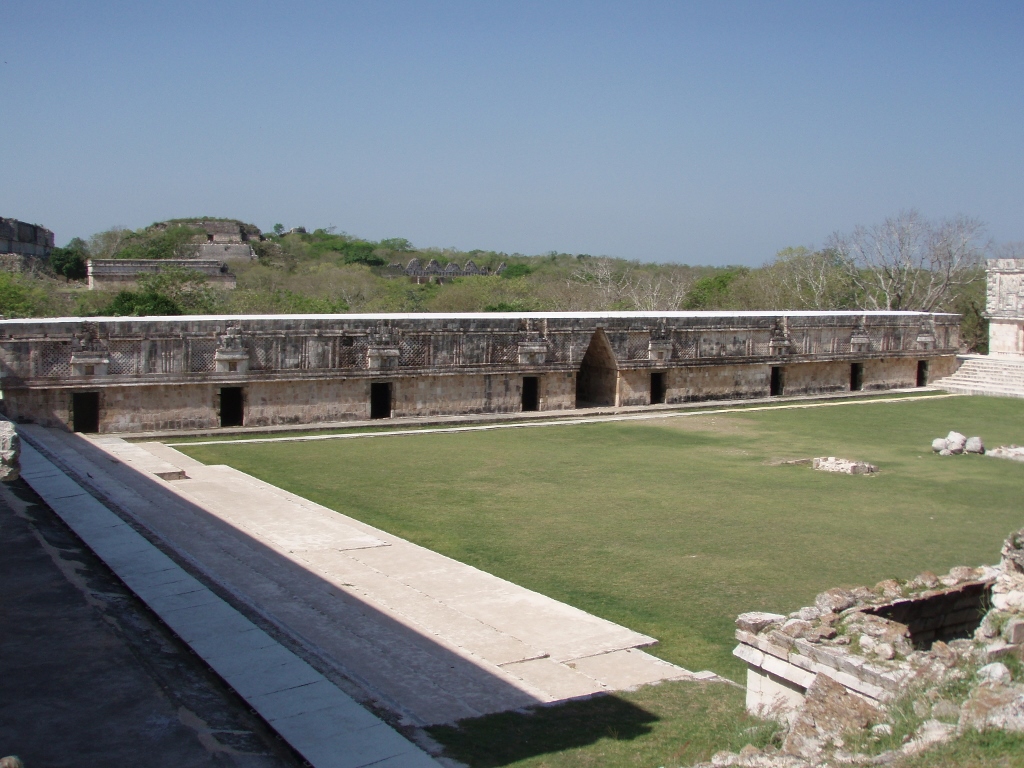 Nunnery Quadrangle – view at the south wing
Nunnery Quadrangle – view at the south wing
From here it was also possible to see why the Spanish named the structure the way they did. Namely, there is a square grassy plateau and around it, on four sides, there are structures with openings leading into small rooms, with 74 of them in total. This reminded the Spanish of cells in a nunnery and of a grassy quadrangle that often exists within large edifices in Europe.
The Nunnery Quadrangle was built in the 10th century and it consists of four palaces positioned at different levels. Since the archaeologists have not found any elements here that suggest daily habitation, it is believed that the structures served as royal palaces that had an administrative function.
As I was standing here, I was thoroughly delighted that I started with my sightseeing so early. The first reason was that there were still not many visitors and so it was easier or, if I may say, nicer to stroll around the site. As it may be seen in the photos, at the time when I was visiting Uxmal, there were very few people around, not only because it was relatively early, but also because Uxmal is not that close to Cancun and the east coast of Yucatan dedicated to tourism and consequently the foreigners mostly tend to head that way. But, this does not reflect the true importance of the site at all. Like Chichén Itzá, Uxmal is also inscribed on the UNESCO’s World Heritage List.
The other reason for my delight was that the weather was ideal – sunny, very pleasantly warm and all the time there was a breeze. In comparison to the heat I was exposed to in Chichén Itzá the day before, this was perfect.
From that elevation where I was standing, there was also a fine view at the rest of Uxmal site.
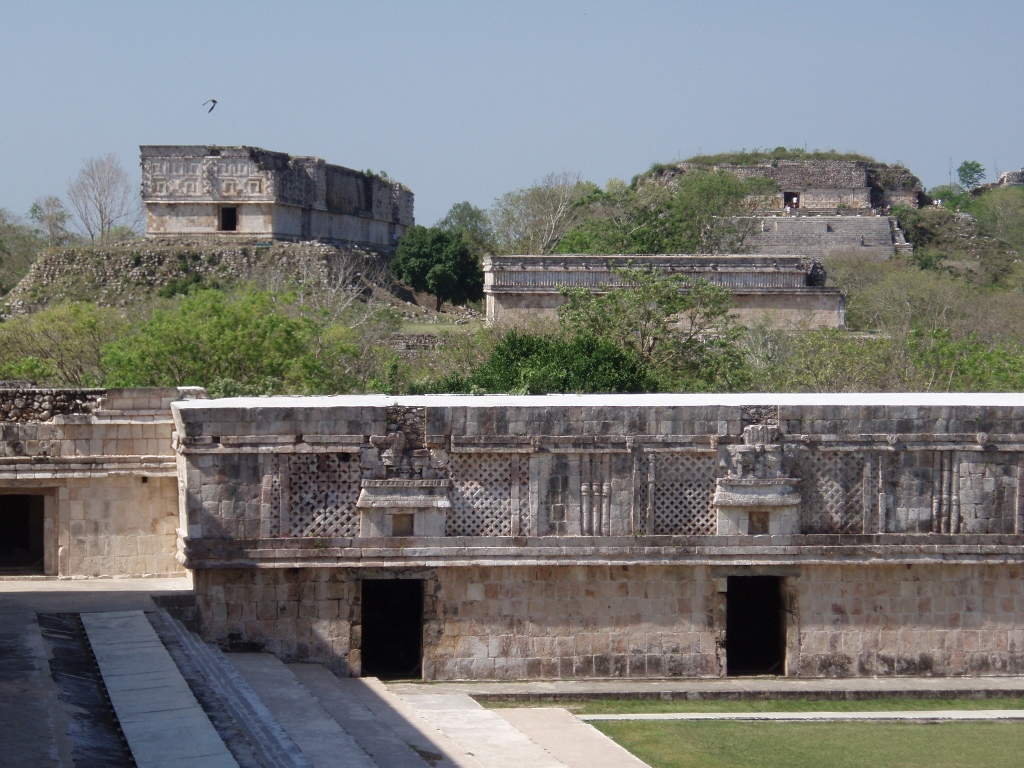 Behind the south wing of the Nunnery Quadrangle there are the Governor’s Palace, House of the Turtles and Great Pyramid
Behind the south wing of the Nunnery Quadrangle there are the Governor’s Palace, House of the Turtles and Great Pyramid
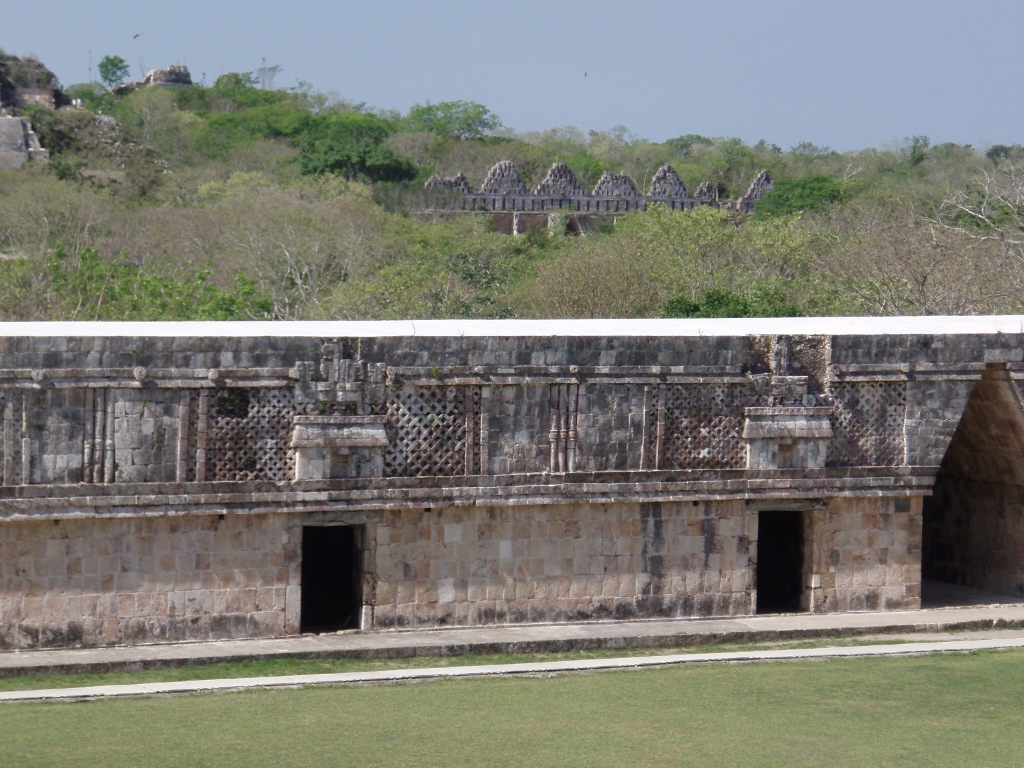 Part of the south wing of the Nunnery Quadrangle, with the top of the Dovecote in the background
Part of the south wing of the Nunnery Quadrangle, with the top of the Dovecote in the background
I continued with my sightseeing by walking in front of the north wing of the Nunnery Quadrangle observing not only the remains of an ancient civilisation, but also some small animals that find their living space here – local iguanas around half a metre long, as well as some small birds residing in those “nunnery cells.”
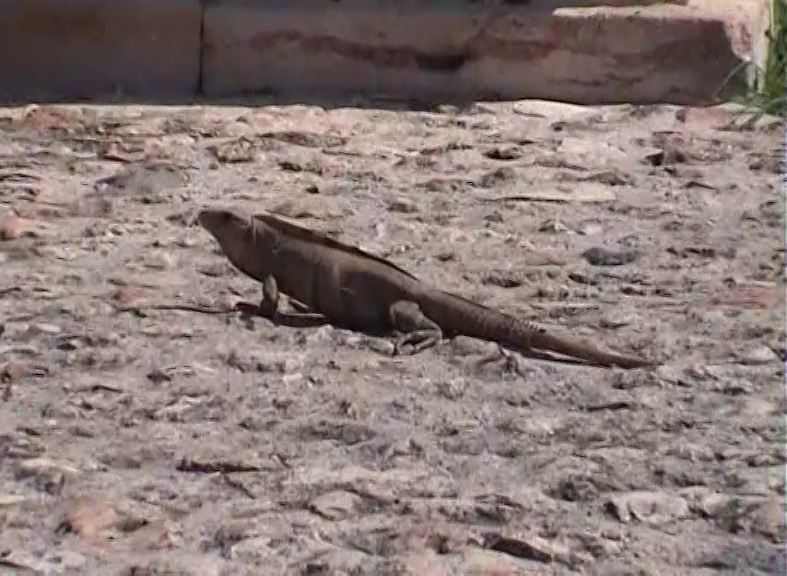 Local iguana
Local iguana
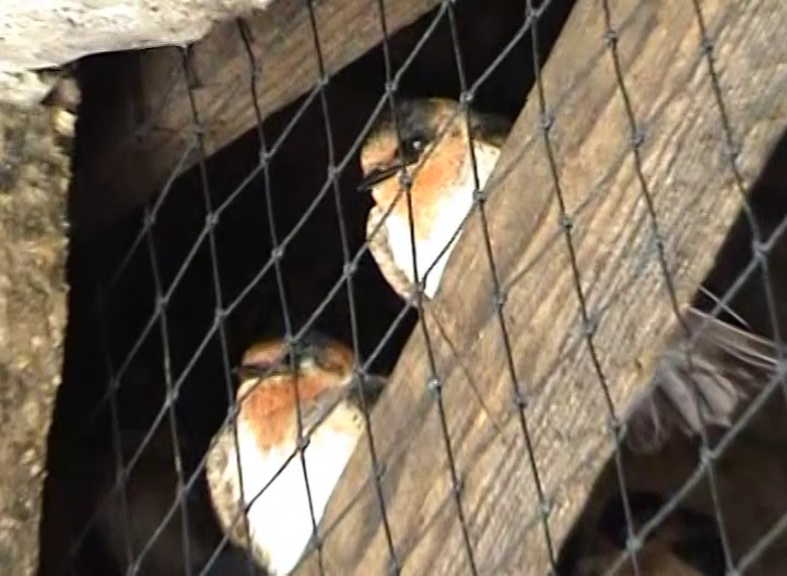 Contemporary dwellers of the “nunnery cells”
Contemporary dwellers of the “nunnery cells”
Still, the main reason for my sightseeing here were these structures and after a short fauna-focused break I redirected my attention.
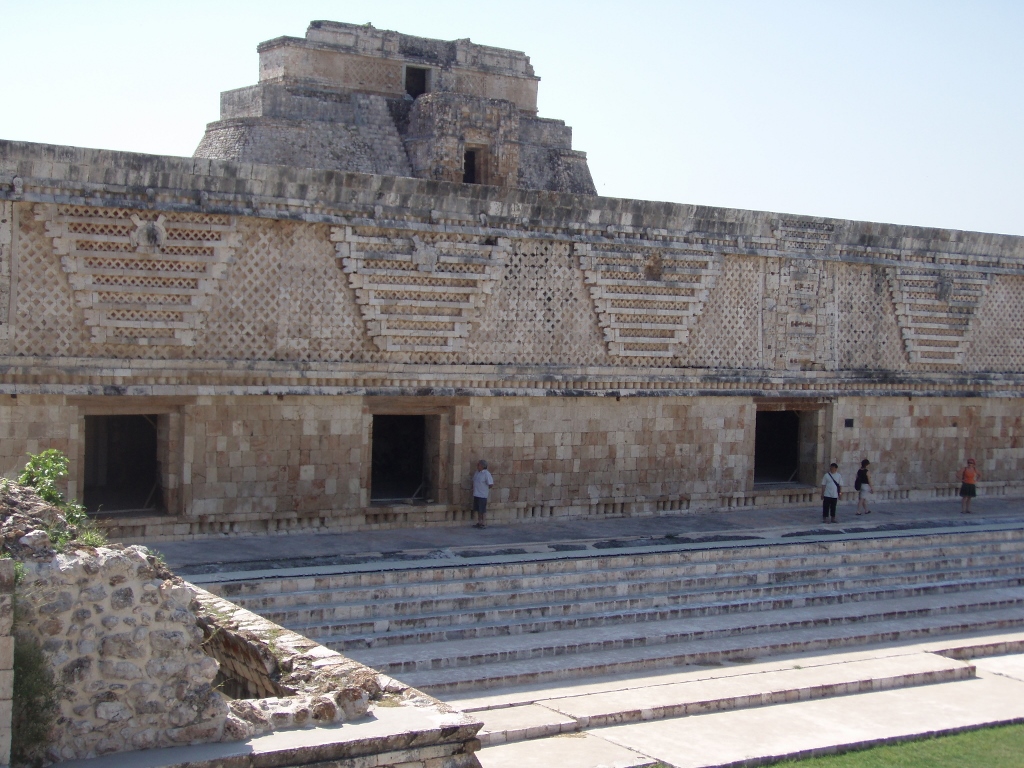 Nunnery Quadrangle – view at the east wing, with the Pyramid of the Soothsayer in the background
Nunnery Quadrangle – view at the east wing, with the Pyramid of the Soothsayer in the background
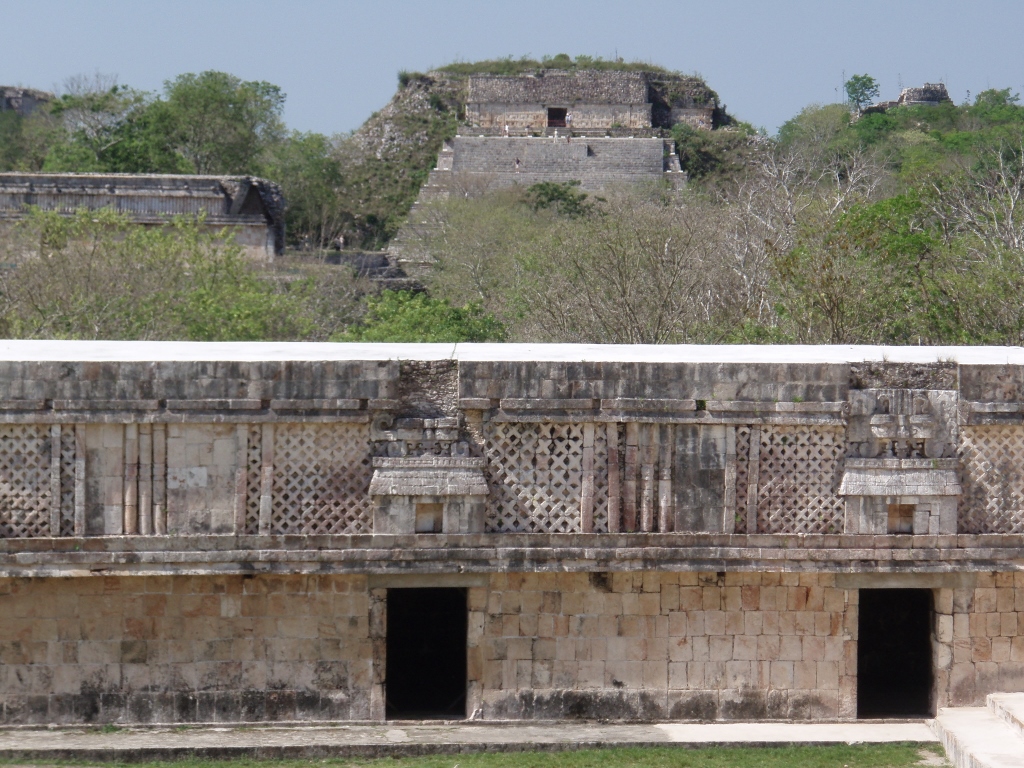 Nunnery Quadrangle – view at the south wing, with the top of the Great Pyramid in the background
Nunnery Quadrangle – view at the south wing, with the top of the Great Pyramid in the background
Already in the previous two photos it is possible to see well the elements of the Puuc artistic and architectural style that reached its peak precisely here in Uxmal. Namely, the main characteristic of the Puuc architecture is the division of the facades of the buildings into two horizontal zones. The lower section is rather simple and it consists of carefully dressed stone blocks between which there are doorways. The upper section, however, is very richly decorated either in lace-like motifs or in very complex plastic motifs, while everything is made in the form of a stone mosaic.
This could also be seen very nicely on the front facade of the north palace that is partially in ruins, but what remains is very impressive and so is the wide stairway that descends towards the central lawn. Namely, the north palace is located on the highest level with this complex.
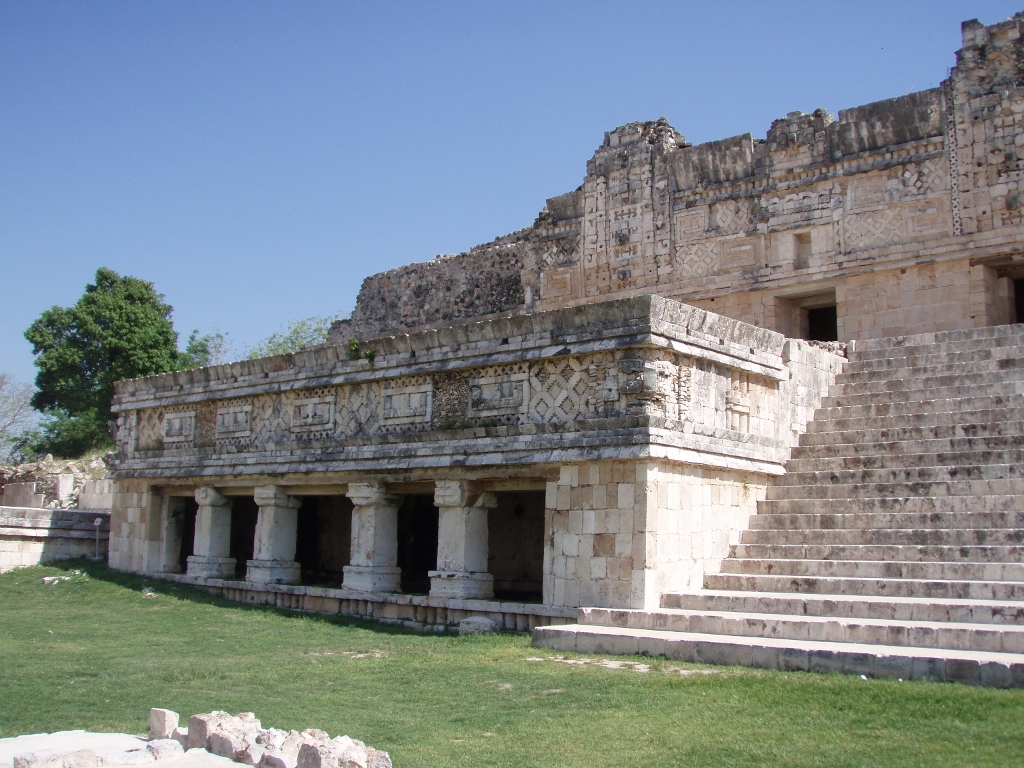 North wing of the Nunnery Quadrangle
North wing of the Nunnery Quadrangle
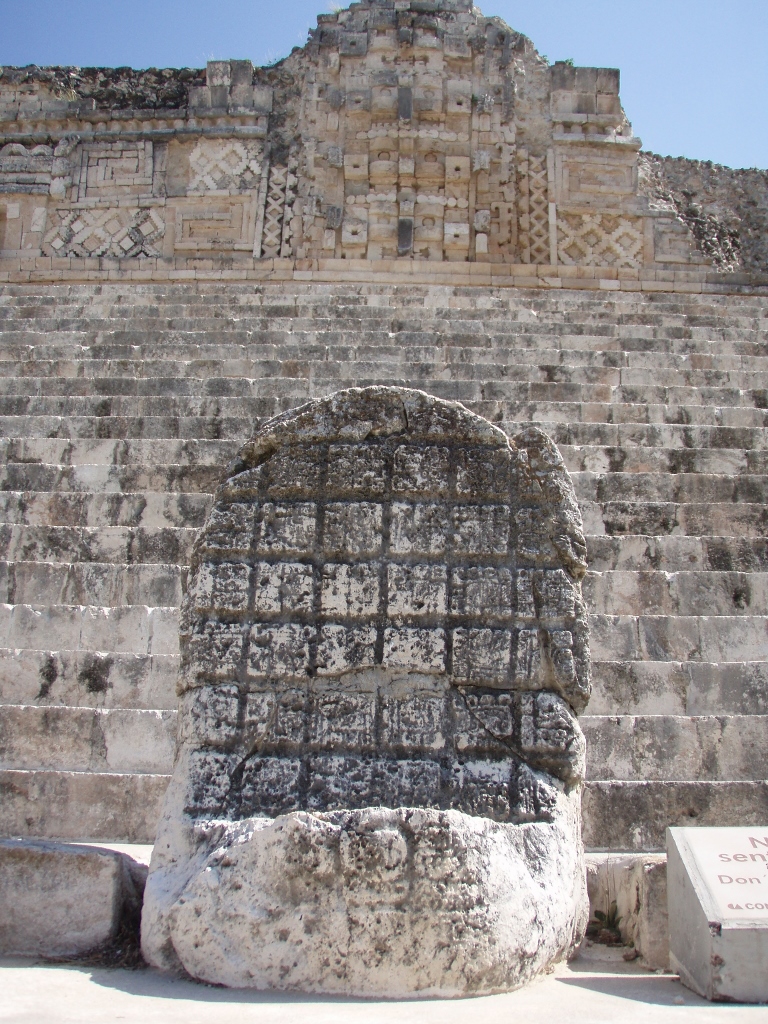 Nunnery Quadrangle – a stone stele, the stairway and the upper section of the facade with the depictions of god Chaac
Nunnery Quadrangle – a stone stele, the stairway and the upper section of the facade with the depictions of god Chaac
However, this morning, when it was directly lit by the Sun, the most picturesque was the west wing of the Nunnery Quadrangle.